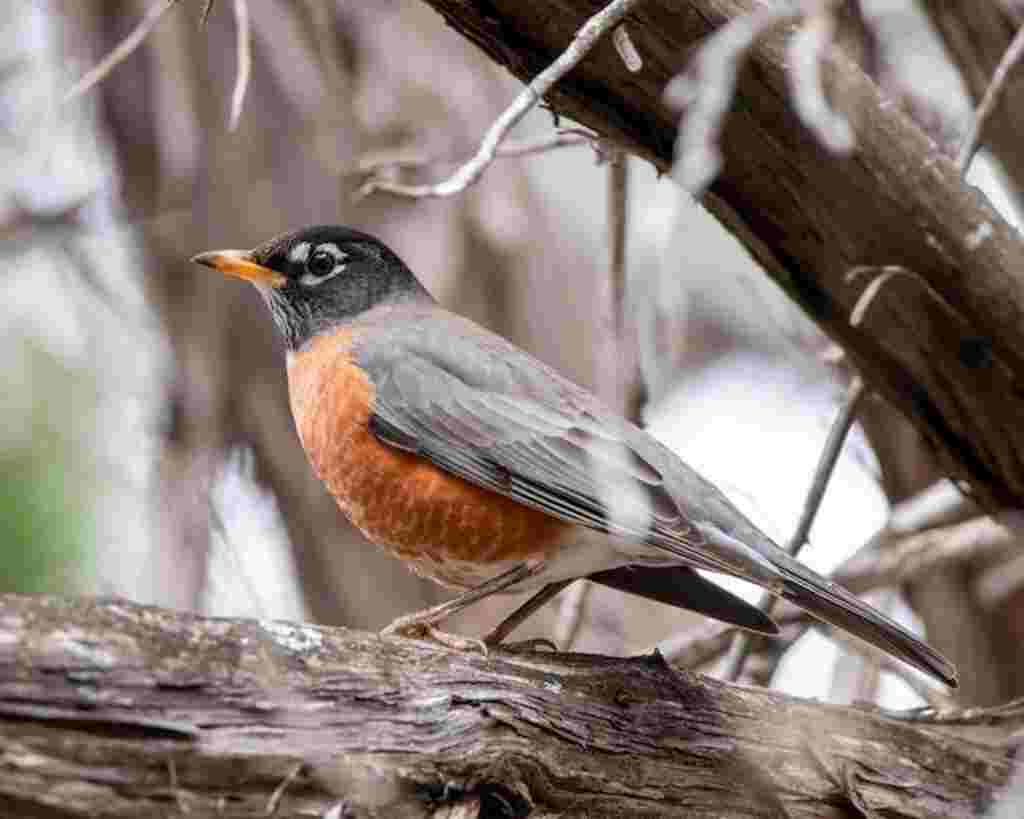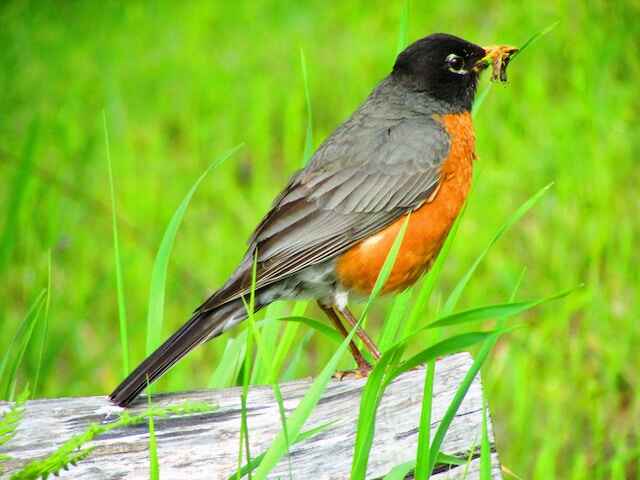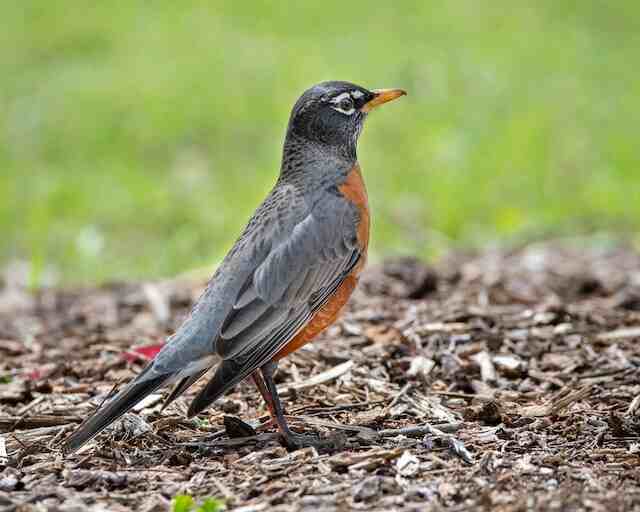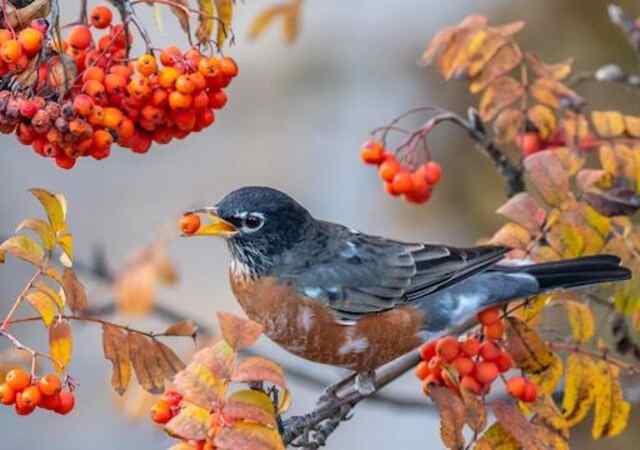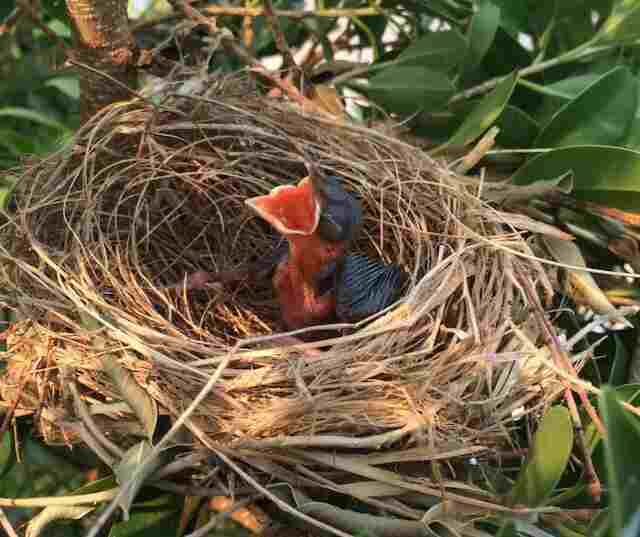The Michigan State Bird is the American Robin, a well-known and beloved bird found throughout the state and across North America. In this guide, we will explore the appearance, behavior, habitat, and more of this iconic bird.
We will also examine the cultural and scientific significance of the American Robin, as well as its role in shaping the ecosystems of Michigan and beyond.
This comprehensive guide provides a wealth of information and insights into the captivating world of Michigan’s State Bird, the American Robin.
Table of Contents
- 1 The American Robin: A Bird of Many States
- 2 History and Significance of the American Robin in Different States
- 3 The Anatomy and Characteristics of the American Robin
- 4 The Behavior and Social Life of American Robins
- 5 The Diet of the American Robin
- 6 The American Robin’s Role in Culture and Society
- 7 American Robin Fun Facts
- 8 The Michigan State Bird: Why the American Robin is a Source of Pride
- 9 FAQs about Michigan State Bird the American Robin
- 9.1 Why is the American Robin the state bird of Michigan?
- 9.2 What makes the state bird of Michigan unusual?
- 9.3 What does the state bird of Michigan look like?
- 9.4 What do American Robins eat?
- 9.5 Do American Robins form communities?
- 9.6 What is the lifespan of an American Robin?
- 9.7 How do American Robins migrate?
- 9.8 What is the American Robin’s scientific name?
- 9.9 Are American Robins monogamous?
- 9.10 How many eggs do American Robins lay?
- 9.11 What is the American Robin’s range?
- 9.12 Do American Robins sing during migration?
- 9.13 What is the American Robin’s winter range?
- 10 Conclusion
- 11 Author
The American Robin: A Bird of Many States
The American Robin (Turdus migratorius) is a widespread bird found throughout North America, and it is beloved by many people in different states. It is the official state bird of Connecticut, Michigan, and Wisconsin, and also the official bird of Washington, D.C.
History and Significance of the American Robin in Different States
Michigan: Why the American Robin is the State Bird
Michigan’s decision to make the American Robin its state bird was part of a broader trend in the early 20th century when many states were choosing official state birds for the first time.
In Michigan’s case, the decision was made in 1931 after a poll of schoolchildren conducted by the Detroit Audubon Society.
The American Robin was the clear favorite among the children, receiving over 100,000 votes, and was subsequently designated as the official state bird.
This grassroots effort to select the state bird has helped to solidify the American Robin’s cultural and ecological significance to Michigan and its residents.
The selection of state birds in the early 20th century was typically driven by public interest and advocacy groups, rather than direct government involvement.
Connecticut: Resilience and Adaptability
Connecticut designated the American Robin as its state bird in 1943. The state recognized the bird’s resilience and adaptability, noting its ability to thrive in a variety of habitats, from dense forests to suburban lawns.
Wisconsin: Ubiquity and Popularity
Wisconsin chose the American Robin as its state bird in 1949, citing its ubiquity and popularity among the state’s residents. The Wisconsin legislature also noted the American Robin’s importance as a migratory bird, with many individuals passing through the state on their annual journeys.
Vermont, Oregon, and Connecticut
Other states that have chosen the American Robin as their official state bird include Vermont, Oregon, and Connecticut. In each case, the selection of the American Robin reflects the bird’s cultural and ecological significance to the state and its residents.
Indigenous Cultures
Beyond its status as an official state bird, the American Robin has played an important role in the folklore and traditions of many indigenous cultures throughout North America.
For example, some Native American tribes regarded the American Robin as a symbol of fertility and renewal and incorporated it into their rituals and ceremonies.
The Anatomy and Characteristics of the American Robin
The American Robin is a medium-sized songbird, typically measuring 9-11 inches in length and weighing 2-3 ounces. It has a distinctive appearance, with a rusty-red breast, gray-brown back, and white belly. The head is black with a white eye-ring, and the bill is yellow and slightly curved.
Unique Features and Adaptations of the American Robin
One of the most notable features of the American Robin is its keen eyesight. This bird has excellent vision and can detect prey from a considerable distance. It also has a unique adaptation that allows it to see its prey through the ground.
When searching for food, the American Robin tilts its head to the side and listens for the movement of worms and insects beneath the soil. It then uses its sharp bill to quickly dig them out.
Another unique adaptation of the American Robin is its ability to withstand extreme temperatures. This bird can survive in a wide range of climates, from the hot and dry southwestern United States to the cold and snowy regions of Canada.
To stay warm in cold weather, the American Robin fluffs up its feathers to create an insulating layer of air. It also shivers to generate heat, a behavior that is rare in birds.
Comparison to Other Similar Bird Species
The American Robin is part of the thrush family, which includes other familiar species such as the Eastern Bluebird and the Wood Thrush. Compared to these birds, the American Robin is larger and more robust, with a longer tail and stronger legs. It is also more adaptable, with a wider range of habitats and behaviors.
In contrast, the Eastern Bluebird is a cavity nester that prefers open grasslands and meadows, while the Wood Thrush is a forest-dwelling bird with a flute-like song.
By comparison, the American Robin is a generalist species that can thrive in a variety of environments and has a distinctive, melodic song that is a familiar sound throughout its range.
| Topic | Information |
|---|---|
| Physical Description | Medium-sized songbird measuring 9-11 inches in length and weighing 2-3 ounces. Rusty-red breast, gray-brown back, white belly. Black head with white eye-ring. Yellow, slightly curved bill. |
| Unique Features and Adaptations | – Excellent vision, can detect prey from a distance. – Can see prey through the ground. – Ability to withstand extreme temperatures. – Fluffs feathers to create insulation. – Shivers to generate heat. |
| Comparison to Other Species | – Larger and more robust than Eastern Bluebird and Wood Thrush. – More adaptable to a wider range of habitats and behaviors. – Eastern Bluebird is a cavity nester that prefers open grasslands. |
The Behavior and Social Life of American Robins
The American Robin is a highly social bird, often found in large flocks during the winter months. These flocks can number in the thousands and are an impressive sight, with the birds moving in unison as they forage for food.
Social Behavior and Communication among American Robins
American Robins are known for their distinctive vocalizations, which are used for communication within the flock. They have a wide range of calls and songs, including territorial songs, alarm calls, and courtship songs. In addition to vocalizations, they also use body language and visual cues to communicate with one another.
Nesting and Breeding Habits of American Robins
American Robins are monogamous and typically mate for life. They begin breeding in early spring, with the female building the nest and the male bringing her food.
The nest is a cup-shaped structure made of grass, twigs, and mud, and is typically located in a tree or shrub. American Robins lay between three to five eggs, which hatch after about two weeks.
The Role of American Robins in Ecosystem Dynamics
American Robins play a vital role in maintaining the health and balance of ecosystems. They are omnivorous and consume a wide variety of insects, including beetles, caterpillars, and earthworms. In doing so, they help to control insect populations and prevent them from causing damage to crops and gardens.
How to Attract American Robins to Your Backyard?
If you want to attract American Robins to your backyard, there are several things you can do. Providing a source of water, such as a bird bath or fountain, is essential, as is providing a variety of food sources, including berries, fruits, and insects.
You can also create nesting sites by placing nesting boxes or baskets in trees or shrubs. By understanding the behavior and social life of American Robins, we can appreciate the complexity of these birds and their important role in the natural world.
From their vocalizations and nesting habits to their ecological significance and how to attract them to our own backyards, the American Robin is a fascinating species that deserves our attention and admiration.
| Section | Key Points |
|---|---|
| Social behavior and communication | American Robins use vocalizations, body language, and visual cues for communication within the flock. |
| Nesting and breeding habits | American Robins are monogamous and typically mate for life. They build cup-shaped nests and lay 3-5 eggs. |
| Role in ecosystem dynamics | American Robins are omnivorous and consume a wide variety of insects, playing an important role in controlling insect populations. |
| How to attract American Robins | Providing a water source, a variety of food sources, and nesting sites can help attract American Robins to your backyard. |
The Diet of the American Robin
The American Robin’s diet is diverse and adaptable, allowing it to thrive in a wide range of environments across North America. In this chapter, we will explore the Robin’s dietary habits in detail, examining the relationship between the bird and its food sources, and the role of its diet in the ecosystem.
Overview of the American Robin’s Dietary Habits
The American Robin is an omnivore, meaning it eats both plant and animal matter. Its diet consists of a variety of foods, including fruits, berries, insects, and worms. The Robin’s diet can vary depending on its location and the time of year.
During the breeding season, for example, the Robin’s diet may consist mainly of insects, while in the winter it may shift to a diet of fruits and berries.
The Relationship between the American Robin and its Food Sources
The American Robin has a close relationship with its food sources. It uses its keen eyesight to locate its prey, which it captures with a quick dash and a snap of its bill.
The Robin is also known to follow earthworms as they emerge from the ground after a rain, using its sharp eyesight to spot them on the surface.
In addition to hunting, the Robin also forages for fruits and berries, often gorging itself on the abundant food sources during the fall migration.
The Importance of the American Robin’s Diet in the Ecosystem
The American Robin plays an important role in the ecosystem as both a consumer and a distributor of seeds. Its consumption of insects helps to control populations of harmful insects, while its distribution of seeds helps to disperse plants and promote biodiversity. The Robin’s diet also plays a vital role in the food web, providing a food source for many other species.
Tips for Feeding American Robins in Your Backyard
If you want to attract American Robins to your backyard, consider offering foods such as mealworms, fruit, and suet. Providing a birdbath with fresh water can also attract Robins, as they enjoy bathing and drinking in shallow water.
Keep in mind that Robins prefer open spaces with a clear view of their surroundings, so avoid placing feeders in densely wooded areas. Also, avoid feeding Robins bread, as it is low in nutritional value and can be harmful to their health.
Read more: How To Attract Robins To Your Yard? A Step-By-Step Guide!
The American Robin’s Role in Culture and Society
Folklore and Symbolism Associated with the American Robin
The American Robin has a rich history of symbolism and folklore in cultures across the world. Native American tribes such as the Navajo and Hopi saw the bird as a symbol of renewal and fertility. In European mythology, the bird was associated with the arrival of spring and the renewal of life.
Even today, the American Robin is often seen as a symbol of hope and renewal, appearing in literature, art, and popular culture.
The American Robin in Literature and Art
The American Robin has long been a favorite subject of poets, writers, and artists. William Wordsworth’s poem “The Robin” celebrates the bird’s arrival in spring, while John James Audubon’s illustrations capture its beauty and grace.
The American Robin has also appeared in countless works of literature, from children’s books to literary classics, cementing its place in the cultural imagination.
Current Threats to the American Robin Population and Conservation Efforts
The American Robin is facing a number of threats to its population, including habitat loss, pesticide use, and climate change. These threats have led to declining populations in some areas, prompting conservation efforts aimed at protecting the bird and its habitat.
These efforts include habitat restoration projects, public education campaigns, and monitoring programs designed to track the bird’s populations and behavior.
The Role of Citizen Science in Monitoring American Robin Populations
Citizen science has proven to be an effective tool in monitoring American Robin populations and understanding their behavior and ecology.
By engaging ordinary people in data collection and monitoring efforts, researchers can gather a wealth of information about the bird’s distribution, population trends, and behavior.
Citizen science also provides an opportunity for people to connect with nature and contribute to conservation efforts, making it a valuable tool for both researchers and the public.
| Section | Summary |
|---|---|
| Folklore and Symbolism | The American Robin has a rich history of symbolism and folklore, representing renewal and fertility in Native American cultures and the arrival of spring in European mythology. It continues to be a symbol of hope and renewal in popular culture. |
| Literature and Art | The American Robin is a popular subject in poetry, art, and literature, appearing in works by William Wordsworth, John James Audubon, and countless others. |
| Threats and Conservation | The American Robin faces threats such as habitat loss, pesticide use, and climate change. Conservation efforts include habitat restoration, public education, and monitoring programs. |
| Citizen Science | Citizen science allows ordinary people to contribute to monitoring efforts and gather information about the bird’s behavior and distribution. It also provides an opportunity for public engagement and connection with nature. |
American Robin Fun Facts
The American Robin is a species with a fascinating history and many unique qualities. In this chapter, we will explore some of the most interesting and lesser-known facts about this iconic bird.
Scientific Classification and Evolutionary History of the American Robin
- The American Robin belongs to the thrush family, which includes more than 160 species worldwide
- Its scientific name, Turdus migratorius, comes from the Latin word for “thrush” and reflects the species’ migratory habits
- American Robins are thought to have evolved in Eurasia before spreading to North America
Unique Behaviors and Characteristics of American Robins
- American Robins are known for their distinctive red breast, but their coloration varies based on gender and age
- They have an impressive sense of sight, with the ability to detect worms and other prey from a distance
- American Robins are also known for their hopping gait, which is due to the length of their legs and their preference for walking rather than running
Lesser-Known Facts about the American Robin’s Life Cycle and Habitat
- American Robins are monogamous and typically mate for life
- They build their nests primarily out of mud and grass, often on ledges or in the crotch of a tree
- Despite their name, American Robins are not exclusively found in North America and can also be found in parts of Central and South America
The Connection between American Robins and Climate Change
- Changes in weather patterns and temperature can affect the timing of American Robin migrations and breeding seasons
- Habitat loss due to climate change can also have a significant impact on American Robin populations
- As a migratory species, American Robins are particularly vulnerable to the effects of climate change, which can disrupt their traditional migratory routes and timing
Overall, the American Robin is a species that continues to fascinate and intrigue researchers and bird enthusiasts alike. Its unique behaviors and characteristics, coupled with its important ecological role, make it a species worthy of study and conservation efforts.
The Michigan State Bird: Why the American Robin is a Source of Pride
The American Robin has been the official state bird of Michigan since 1931, and it holds a special place in the hearts of many residents of the Great Lakes State. In this chapter, we will explore the rich history and cultural significance of the American Robin in Michigan, as well as the unique characteristics that make it stand out from other state birds.
History and Cultural Significance of Michigan’s State Bird
Michigan’s decision to adopt the American Robin as its state bird was based on its widespread presence throughout the state, as well as its reputation as a symbol of spring and renewal.
The American Robin’s arrival in Michigan each year is eagerly anticipated by residents as a sign that winter is coming to an end and warmer weather is on the way.
Comparison to Other State Birds and What Makes the American Robin Stand Out
Compared to other state birds, the American Robin is relatively common, with several other states also adopting it as their official bird. However, what sets the Michigan state bird apart is its role as a harbinger of spring and its widespread presence in the state’s parks, gardens, and forests.
Additionally, the American Robin’s distinctive red breast and melodic song make it a beloved and recognizable species among Michigan residents.
Future Prospects for the American Robin in Michigan and Beyond
Despite its current status as Michigan’s state bird, the American Robin faces numerous threats in the state and across North America, including habitat loss, climate change, and predation. However, ongoing conservation efforts, such as habitat restoration and monitoring programs, offer hope for the future of this iconic species.
In addition, citizen science initiatives and public education campaigns can raise awareness about the importance of protecting the American Robin and its habitats for future generations.
Overall, the American Robin holds a special place in the hearts of Michigan residents as a symbol of spring and renewal, and its widespread presence throughout the state makes it a source of pride and wonder.
By understanding its history, cultural significance, and unique characteristics, we can work together to ensure the future of this beloved bird and the ecosystems it inhabits.
FAQs about Michigan State Bird the American Robin
Why is the American Robin the state bird of Michigan?
The American Robin was designated as Michigan’s state bird in 1931 due to its abundance and widespread distribution throughout the state, as well as its popularity as a songbird and symbol of spring.
What makes the state bird of Michigan unusual?
While the American Robin is a common bird throughout North America, it is somewhat unusual as a state bird choice because it is not particularly distinctive to Michigan and is also the state bird of Connecticut and Wisconsin.
What does the state bird of Michigan look like?
The American Robin has a distinctive orange-red breast, grayish-brown back, and white eye-ring. Males and females look similar, but males tend to have darker heads and more vibrant coloring overall.
What do American Robins eat?
American Robins primarily feed on insects and other invertebrates during the breeding season, but they also eat fruits and berries during the fall and winter months. They are known to be particularly fond of earthworms.
Do American Robins form communities?
While American Robins are primarily solitary birds, they may form loose groups or flocks during the non-breeding season when food resources are scarce. These flocks may contain dozens of individuals and may include other bird species as well.
What is the lifespan of an American Robin?
The lifespan of an American Robin is typically 2-3 years, although some individuals have been known to live up to 14 years in the wild.
How do American Robins migrate?
American Robins are considered partial migrants, meaning that some populations remain in their breeding range year-round, while others migrate southward during the fall and winter months. They generally travel at night and follow major flyways.
What is the American Robin’s scientific name?
The American Robin’s scientific name is Turdus migratorius. It belongs to the family Turdidae, which includes other thrushes such as the Eastern Bluebird and Wood Thrush.
Are American Robins monogamous?
Yes, American Robins are monogamous and typically mate for one breeding season. However, some individuals may form pair bonds that last multiple breeding seasons.
How many eggs do American Robins lay?
American Robins typically lay 3-4 eggs per clutch, although some individuals may lay up to 6 eggs. The eggs are a pale blue-green color and are incubated for 12-14 days before hatching.
What is the American Robin’s range?
The American Robin is found throughout North America, from Alaska and Canada down to Mexico and parts of Central America. During the breeding season, they are found primarily in the northern and central portions of this range.
Do American Robins sing during migration?
Yes, American Robins are known to sing during migration, both while traveling and upon arriving at their destination. They may use singing to establish territory and attract a mate.
What is the American Robin’s winter range?
During the winter months, American Robins can be found in the southern portions of their range, including parts of the United States, Mexico, and Central America. Some individuals may also remain in their breeding range year-round, especially in areas with mild winters.
Conclusion
In conclusion, the American Robin is a beloved and iconic bird species in Michigan, recognized as the state bird since 1931. With its distinctive coloring, cheerful song, and widespread distribution throughout the state, the American Robin has become a symbol of spring and a source of pride for Michiganders.
While the species faces challenges from habitat loss and climate change, efforts to conserve and protect the American Robin and its habitat can help ensure that future generations can continue to enjoy this beloved bird.
Related Post:

